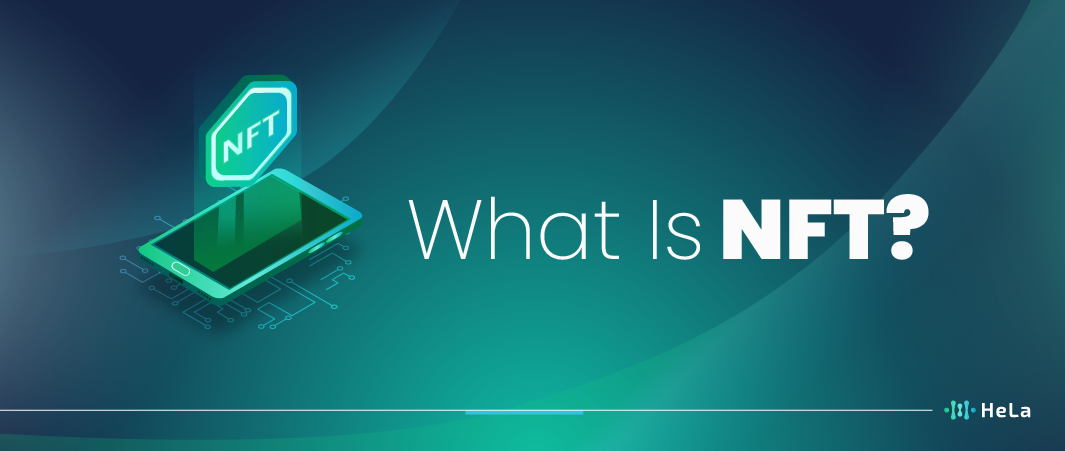The digital realm has always been a hotbed for innovation. But among the various breakthroughs, none have been as intriguing or as debated as the concept of non-fungible tokens (NFTs). But what is NFT, and why has it captured the imagination and investment of millions around the globe?
In the vast world of cryptocurrencies and blockchain technology, NFTs have emerged as a unique proposition, giving digital assets a distinctive value unlike any other. They’re not just another digital coin or a representation of money. Instead, they’ve come to represent ownership in the digital age.
As we delve deeper into the realm of NFTs, it becomes essential to understand their origin, their value proposition, and how they’re changing the landscape of digital ownership, art, and even the broader cultural narrative.
What Is NFT?

NFT, short for Non-Fungible Token, is a digital certificate that works like a unique proof of ownership for something in the digital world. It’s like a special tag that says, “I own this!” These certificates are securely and transparently recorded within a blockchain, a digital ledger system. Unlike regular cryptocurrencies, such as Bitcoin or Ethereum, which you can swap with one another like dollar bills, NFTs are one-of-a-kind. You can’t just trade them like a straight-up swap because each NFT represents something different and special.
Also Read: 12 Best Blockchain Node Providers Powering Web3 to Watch in 2023
Think of NFTs like digital collector’s items. They can represent all sorts of digital stuff, from digital art and music to virtual real estate and even tweets. The blockchain ensures that the ownership is legit and can’t be tampered with. So, when you own an NFT, you can say, “This is mine,” and prove it to the whole world. It’s a way to show off your digital treasures and make sure they’re the real deal.
The Rise and Significance of NFTs in the Digital Age
Let’s delve into the emergence and growing importance of Non-Fungible Tokens (NFTs) in the modern era. NFTs are unique digital assets that have gained immense popularity and attention due to their revolutionary impact on various industries, including art, entertainment, gaming, and finance. NFTs are blockchain-based tokens that represent ownership or proof of authenticity of a particular digital or physical item. They have gained significance in the digital age for several reasons:
Digital Ownership and Authenticity
NFTs provide a way to establish true ownership and provenance of digital assets. This is crucial in a world where digital art, collectibles, and content are increasingly valuable.
Digital Art and Collectibles
NFTs have disrupted the art world by enabling artists to tokenize their creations and sell them directly to collectors. This has opened up new avenues for artists to monetize their work without the need for traditional art galleries.
Entertainment and Media
NFTs have found applications in the entertainment industry, from music to movies and virtual goods in video games. Musicians and filmmakers can release exclusive content or merchandise as NFTs, creating new revenue streams and engaging with their fan base.
Gaming and Virtual Worlds
NFTs are a fundamental part of the blockchain-based metaverse, where virtual land, in-game items, and characters can be bought and sold as NFTs. This has created an economy within virtual worlds, with real-world value.
Financial Implications
NFTs have financial significance as speculative assets and investment opportunities. People have made significant profits by trading NFTs, leading to discussions about their long-term economic impact.
Environmental Concerns
The rise of NFTs has also raised concerns about the environmental impact of blockchain technology, as many NFTs are minted on energy-intensive networks. This has prompted discussions about sustainable NFT practices.
Legal and Intellectual Property Issues
The use of NFTs has introduced complex legal and intellectual property challenges, especially regarding ownership, copyright, and licensing of digital assets.
Challenges and Future Trends
NFTs face challenges related to scalability, interoperability, and regulations. The future of NFTs may involve increased integration with augmented and virtual reality, enhanced security, and broader acceptance in various industries.
Understanding the rise and significance of NFTs in the digital age requires a comprehensive examination of their impact on the way we create, own, trade, and interact with digital assets. This phenomenon represents a fundamental shift in how we perceive and engage with the digital world, and it continues to evolve rapidly, impacting both individuals and industries alike.
How Do NFTs Work?
NFTs, or Non-Fungible Tokens, have gained significant popularity in recent years as a way to represent ownership and authenticity in the digital world. The fundamental technology that underpins NFTs is blockchain. Here’s a more detailed explanation of how NFTs work within the context of blockchain technology:
Blockchain as the Foundation
Blockchain is a distributed and decentralized ledger technology that records transactions across a network of computers. Each transaction is grouped into a block, and these blocks are linked together to form a chain, creating a secure and transparent record of all activities.
Unique Digital Assets
NFTs are essentially unique digital assets, and they can represent a wide range of items, including digital art, collectibles, music, videos, virtual real estate, in-game items, and more. When someone creates an NFT, they mint a token on the blockchain, which serves as a digital certificate of ownership.
Immutability and Verification
The blockchain’s decentralized nature ensures that once data is recorded, it’s extremely difficult to alter or delete. This immutability is crucial for NFTs because it means that the ownership and provenance of the NFT can be easily verified. When you own an NFT, your ownership is securely recorded on the blockchain, making it nearly impossible for anyone to dispute your ownership.
Ownership and Scarcity
When you purchase an NFT, you’re essentially buying a unique token that represents ownership of the associated digital item. This ownership is secured by cryptographic keys, and the ownership information is linked to your digital wallet. This ensures that the NFT remains scarce, as there’s only one legitimate owner for each NFT.
Interoperability
NFTs can be bought, sold, and traded on various online marketplaces that support them. These marketplaces often use standardized protocols, like Ethereum’s ERC-721 or ERC-1155, to ensure compatibility and ease of exchange between different NFTs and platforms. This interoperability is one of the reasons NFTs have become so versatile and popular.
Provenance and Royalties
One of the notable features of NFTs is that the blockchain also records the entire transaction history of an NFT. This information can include the original creator, previous owners, and sale prices. Additionally, creators can embed smart contracts that ensure they receive royalties each time their NFT is resold, creating an ongoing revenue stream for artists and content creators.
Digital Ownership Revolution
NFTs have been praised for their potential to revolutionize the concept of digital ownership. In the past, digital files were easily copied and shared without a clear way to establish ownership. NFTs provide a solution to this problem, giving digital assets a level of ownership and uniqueness similar to physical items.
NFTs leverage blockchain technology to create unique, verifiable, and tradable digital assets. The ownership and transaction history of each NFT are securely recorded on the blockchain, giving creators and buyers a clear and tamper-proof record of the item’s provenance and ownership. This innovation has unlocked a wide range of possibilities for artists, collectors, gamers, and other content creators in the digital realm.
Controversies and Criticisms Surrounding NFTs

NFTs, or non-fungible tokens, have certainly made waves in the world of digital art and collectibles. However, they haven’t been without their fair share of controversies and criticisms. One significant area of concern is the environmental impact associated with NFTs due to their reliance on blockchain technology. Many NFTs are built on blockchains like Ethereum, which primarily use a proof-of-work consensus mechanism. This energy-intensive process requires powerful computers to solve complex mathematical puzzles, consuming vast amounts of electricity. Critics argue that the carbon footprint of such systems is alarming and unsustainable, particularly when we consider the pressing global issues related to climate change.
In addition to the environmental concerns, the speculative nature of the NFT market has raised eyebrows. Prices for certain NFTs have skyrocketed into the millions, leading to questions about whether a speculative bubble is forming in the market. Some argue that the current hype and rapid price appreciation might not be rooted in the true value of the digital assets but rather in the fervor of collectors and investors seeking quick profits. This has drawn parallels to the dot-com bubble of the late 1990s and the more recent cryptocurrency boom and bust cycles, where assets were valued well beyond their intrinsic worth.
Furthermore, critics have raised issues related to copyright and intellectual property in the NFT space. It’s not always clear who truly owns the rights to a digital creation, and NFTs have been linked to instances of copyright infringement and plagiarism. The concept of ownership in the digital world is still evolving, and this lack of clarity can create legal and ethical challenges.
The Future of NFTs

The future of NFTs is poised to reshape digital ownership and disrupt multiple industries. NFTs, or non-fungible tokens, represent unique digital assets, and their potential applications are vast. In decentralized finance (DeFi), NFTs could serve as collateral, opening up innovative financial possibilities. Gaming is another sector where NFTs are gaining traction, enabling true ownership of in-game items and characters. NFTs may eventually foster cross-game interoperability and redefine the gaming experience. Additionally, NFTs have the potential to revolutionize the digitization of real-world assets, making it easier to buy, sell, and invest in physical assets like real estate and artwork.
Also Read: What is Wrapped Tokens? Purpose and Functionality
One major concern with NFTs has been their environmental impact, notably their association with energy-intensive blockchains like Ethereum. However, the future holds promise in addressing this issue. Innovations like layer 2 solutions and eco-friendly blockchains aim to enhance the scalability and sustainability of NFT transactions. Layer 2 solutions, such as Optimistic Rollups and zk-Rollups, improve efficiency, while blockchain platforms prioritizing sustainability, like Tezos and Flow, offer alternatives to energy-intensive options. As technology evolves and environmental concerns are mitigated, NFTs are poised to emerge as a transformative force in the realms of digital ownership, asset management, and decentralized finance.
Conclusion
The digital landscape is ever-evolving, and NFTs (Non-Fungible Tokens) are its latest and most debated frontier. Representing a seismic shift in how we perceive value and ownership in the digital realm, NFTs have carved a niche that’s hard to ignore.
NFTs have gained widespread attention and prominence in recent years. They are unique digital assets that utilize blockchain technology to certify their authenticity and ownership. Whether it’s digital art, collectibles, virtual real estate, or even tweets, NFTs have disrupted traditional notions of value and ownership, creating a stir in various industries.
One of the most profound implications of NFTs is their potential to revolutionize the art world. They empower artists to directly sell their digital creations to a global audience, bypassing traditional gatekeepers like galleries and auction houses. This democratization of the art market has opened up new avenues for both established and emerging artists to monetize their work and gain recognition.
NFTs also hold the promise of redefining ownership in the digital age. While you can easily duplicate a digital file, NFTs provide a way to prove your unique ownership of the original. This concept has significant implications for intellectual property, licensing, and the way we interact with digital content.
However, NFTs are not without their controversies and challenges. Environmental concerns have been raised due to the energy-intensive nature of some blockchain networks used for NFTs. Additionally, the hype around NFTs has led to speculation and price volatility, which can create financial risks for investors.
As we stand at the cusp of this digital revolution, it becomes crucial for us to understand, adapt, and innovate. After all, NFTs aren’t just a fleeting trend; they’re a testament to the endless possibilities of the digital age. To harness their potential while addressing their challenges, we must strike a balance between innovation and responsibility. This means developing more sustainable blockchain technologies, addressing issues related to copyright and intellectual property, and finding ways to ensure the accessibility and inclusivity of the NFT space for creators and collectors alike.
Disclaimer: The information provided by HeLa Labs in this article is intended for general informational purposes and does not reflect the company’s opinion. It is not intended as investment advice or recommendations. Readers are strongly advised to conduct their own thorough research and consult with a qualified financial advisor before making any financial decisions.

I am Carina Caringal, a technical writer specializing in blockchain engineering concepts, decentralized systems, crypto infrastructure, and Web3 technologies. My work focuses on analyzing and translating complex technical mechanisms into precise, structured, and insightful content for both developers and non-technical readers who want a deeper understanding of the decentralized ecosystem.
My background in blockchain and cryptocurrency is rooted in years of independent research, continuous learning, and hands-on exploration across multiple protocols and network architectures. I study the underlying mechanics of distributed ledger technology, from consensus algorithms and smart contract logic to network scalability, security models, cryptographic principles, and interoperability frameworks. This technical foundation shapes the way I approach every article, ensuring accuracy, depth, and relevance.
- Carina Caringalhttps://helalabs.com/blog/author/carina-caringal/
- Carina Caringalhttps://helalabs.com/blog/author/carina-caringal/
- Carina Caringalhttps://helalabs.com/blog/author/carina-caringal/
- Carina Caringalhttps://helalabs.com/blog/author/carina-caringal/


Pingback: 10 Best Meme Coin Development Companies to Know in 2025 (Updated List) - HeLa